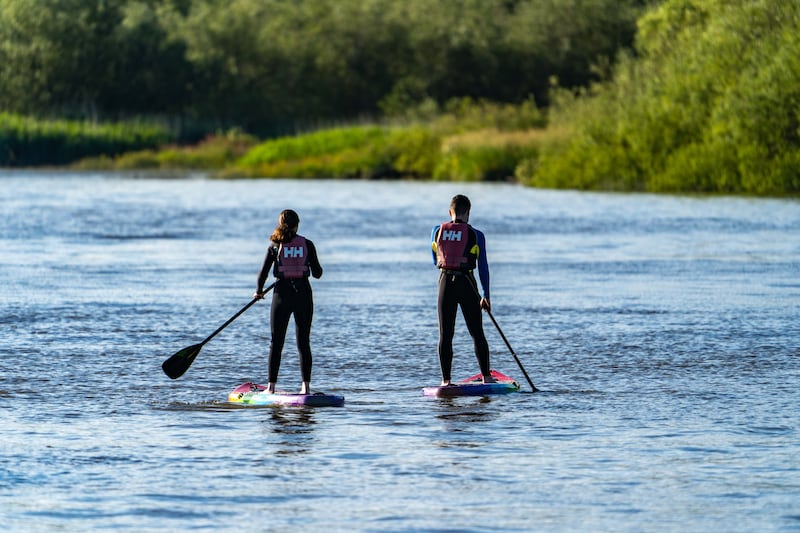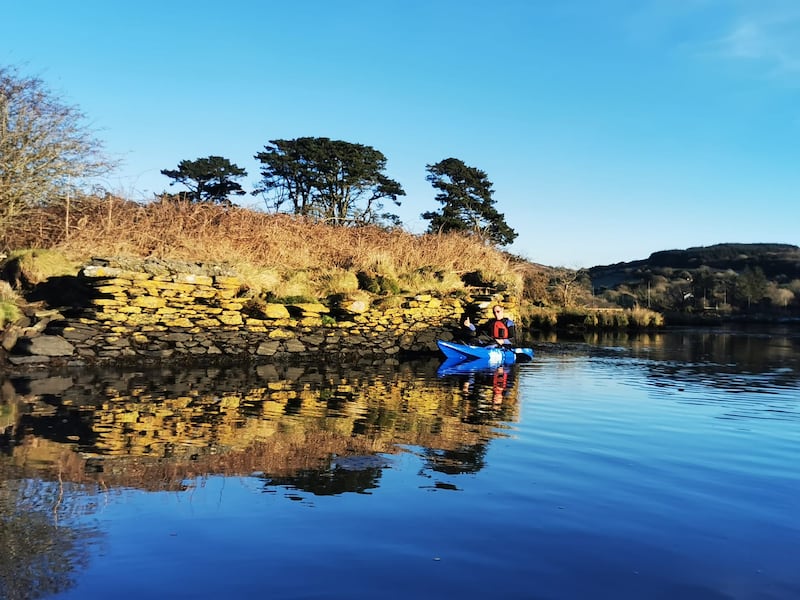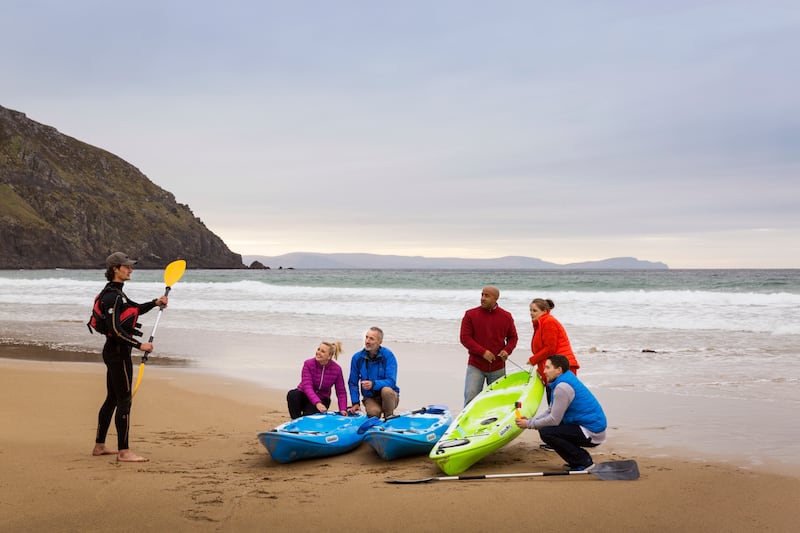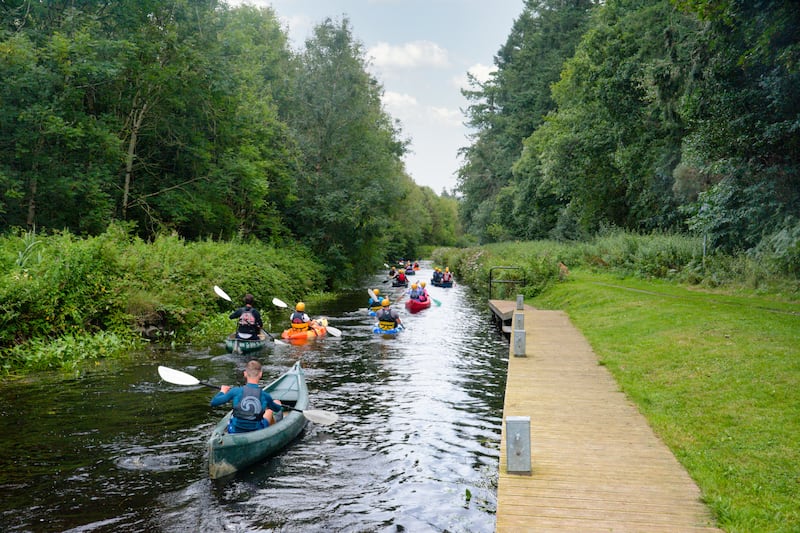A lust for travel is a funny desire. We may dream of faraway places that promise adventure and wonder, but there are times when, for all the effort required to get to a coveted destination, we would have done better to consider the options on our doorstep at home.
This is particularly true when it comes to kayaking. When you step into a kayak and push off from shore, you are instantly transported to another realm, where adventure lies around every corner and your perspective alters as you acclimatise to the lapping of the waves and the wind in your face.
I have lived in west Cork for more than a quarter of a century and it took me longer than it should have to buy a kayak and start using it on a regular basis. The initial investment is not inconsiderable – it can cost from €450-€650 for a kayak with a seat, paddle and life jacket. For transporting your kayak to the water, you will need roof bars for your car, and ratchet straps or thick kayak-ready bungee cords to latch the kayak to the bars tightly. After that, there is the time commitment involved in using it and planning around it.
But the rewards are immense. Today’s standard sea kayaks are hardy vessels that can go just about anywhere and are virtually impossible to capsize due to their stability. They are light enough for the average person to be able to lift and carry for a short distance and they often come with compartments for you to store your bits and pieces, although an item that is worth getting is a waterproof dry bag.
As with all water activities, kayaking is far from fun if you don’t take simple, basic precautions beforehand. Preparation and a strong understanding of your ability level are key, and safety considerations are paramount: kayak with other people and always have the means to attract attention if you encounter any trouble. Getting lessons before your first adventure on the water is a very good idea. A good instructor will help you to familiarise yourself with the kayak, the paddles, how you interact with both, and they will also teach you to assess the weather and water conditions.
Kayaking is the kind of thing that you can do at the last minute on a Saturday morning – all you have to do is load up and head to your chosen location. It is vital, however, to be informed of how the conditions may affect your trip. If you are kayaking at sea or on a large lake, for example, you need to be mindful of the winds. Kayaks sit quite high on the water, with much of their light plastic hull exposed to the wind and even moderate winds will blow you off-course in a short space of time.
You don’t need to go far out to sea at all. In truth, hugging the coast is arguably more rewarding than trying to reach an island or cross a bay – these latter two can be fraught with all kinds of hazards that you do need to plan for. When it comes to inland waterways, local knowledge is also vital. Is this river navigable? Or does it flow along unhindered for a stretch but end in a beautiful but hazardous waterfall after one kilometre?
Since my first flotation out into Dunmanus Bay, I’ve endeavoured to bring my kayaks with me wherever and whenever possible. I’ve also taken kayak tours in places I’ve visited, from Killarney to Ketchikan, Alaska. But there is no need to go to foreign climes when the world of kayaking is on our doorstep, via our coastline, which stretches to more than 3,000km, and in our enchanting inland waterways.
It is also worth noting that the trend these days is for “slow kayaking” – where the emphasis is on pootling along and appreciating every aspect of your journey, as opposed to embarking on challenging voyages involving rough seas and hundreds of kilometres in the shortest time possible.
“Ninety per cent of people who kayak now just want to get out there,” says Jim Kennedy of Atlantic Sea Kayaking. “To just be independent and connect with nature. It’s not about risking their lives or going out into big seas or anything like that.
“That’s the way our business has gone, certainly. And from our friends in Ireland and other countries, we’re discovering that it’s the same for them. It’s also wonderful to see more and more people getting on the water: There was a time when 6 per cent of mainstream tourists wanted to try an adventure. Now it’s up at 85 and 90 per cent.”
[ Exploring Ireland: Day trips worth taking from Dublin, Cork, Limerick and GalwayOpens in new window ]
The river Blackwater

The river Blackwater is one of Ireland’s greatest rivers and for the most part, it is a very navigable waterway that brings you through some wonderful market towns that are best viewed from the water. If you start at Millstreet in Cork, you can kayak all the way down to the great wide bay at Youghal. Passing through the counties of Cork and Waterford, you get to enjoy some beautiful stretches along its upper reaches. There are just two weirs to contend with by the town of Fermoy and here, you can get around the problem by portage – the term we kayakers use to refer to getting out of the water, picking up your kayak and walking the short distance to a safe point beyond the weir.
The sights become even more spectacular after that point, with the village of Ballyduff and St Mary’s Abbey at Glencairn being worth a detour. After the river makes a 90-degree right turn at Cappoquin and heads south on its final section, the 300-metre detour up a minor tributary to see Ireland’s only Hindu-gothic bridge at Dromana is particularly rewarding.
As the soft banks are replaced by high cliffs, eye-popping architecture emerges in the form of ruined or refurbished stately homes and the seldom-used moorings and piers hark back to a time when this river was one of the most important waterways of Ireland.
Dunmanus Bay

With the Mizen Peninsula flanking its southern side, the Sheep’s Head Peninsula protecting it from the north and the great bulk of Hungry Hill clearly visible beyond from the Beara Peninsula, Dunmanus Bay can be described as a very doable sized bay. The shallower waters that open southwesterly to the Atlantic make it a perfect location for some mindful sea-kayaking.
The estuary at Durrus provides a wide basin that teems with great birdlife, including Curlews, Herons and Little Egrets. The remains of an old ruined storehouse provide an atmospheric backdrop amid the sylvian banks and a little farther upriver, the remains of an older pier (known locally as the Sand Pier) with its stone steps still visible makes for an interesting architectural discovery.
Farther out into the bay, Mannion Island is an easily accessible offshore island. Moving west, Carbery Island (currently owned by the Sultan of Brunei) is a bit more challenging to reach and not to be attempted without seeking local advice and ensuring conditions are safe.
Pretty much all of the coastline is wonderful, with Ahakista arguably looking the most alluring from the sea, where the pines hug the coast and two pubs call to the thirsty kayaker. The other magical highlight here is the sheltered bay around Dunmanus Castle. Its pier is wonderful and the shallow reaches that stretch inland are a great exploration ground for its birdlife.
The Kingdom

If you are thinking of bringing your own kayak to the Lakes of Killarney, bear mind that permission is required beforehand as it is a special area of conservation. A much better option is to leave your kayak at home and take a tour of Lough Leane with Killarney Kayaking. This involves kayaking past the brightly-stoned Ross Castle, going under natural stone arches and making landfall on Innisfallen Island. Here, you can stroll among the ruins of a seventh-century monastery founded by St Finian Lobhar, spotting some of the local Sika deer, who swam out here and founded a colony of their own. Farther west, another favourite kayaking area is the long narrow estuary of the river Ferta. Launching at the pier in Cahersiveen, you can head upriver, where the rugged Killurly Commons rises majestically before you, looking far taller than its 600 or so metres.
Turning and heading seaward, you sail past Foughil Island and turn into the inlet where the remains of Ballycarbery Castle guard what must have been a precious area in times long past. If you carry on, the tempting view of White Strand comes alongside on your right, and before you are Beginish Island and Valentia Island at the mouth of the estuary.
This part of Kerry is packed with ancient monuments including some of the most superb stone forts. The coastline by Ballinskelligs is a beautiful spot to launch your kayak from the pier-side beach. Once you’re out in the bay which is leeward of the prevailing winds, you get a great view of Ballinskelligs Abbey and the stumpy remains of Ballinskelligs Castle. Horse Island is just offshore, with a wonderful beach where you can pull up your kayak and have a swim.*
Leinster

If you have a mind for a great Irish kayaking odyssey, you will struggle to top the voyage from Dublin to Graiguenamanagh in Co Kilkenny. It is a journey of many parts, where you start in the canals of Dublin and find yourself paddling past the likes of Carlow and the enchanting run of the river Barrow through the Dolmen County – surely one of the best-kept secrets in Ireland. Milford Mill and the span of Goresbridge are eye-catching architectural gems. And if you fancy a break, the water adventures can continue in the geothermally heated 25m outdoor swimming pool of Bagenalstown.
Useful links
iaat.ie: The Irish Association for Adventure Tourism was set up to promote adventure tourism in Ireland and to ensure industry standards.
canoe.ie: This is a great resource site for all things canoeing/kayaking. One vital point to remember if you’re kayaking on inland waterways is to ensure your vessel is correctly cleaned down before transferring it from one waterway to another. This is to avoid cross-contamination of species; where organisms present in one river can cause devastation in another.
bluewaysireland.org: In search of new routes? This website offers a selection of safe, pre-researched kayaking routes. While it is far from a complete list, ask locally wherever you are going and you will discover many more.
* This article was amended on Monday, April 15th, 2024. Horse Island is privately owned and therefore, other than walking on the beach, it cannot be “explored” as an earlier version of the article erroneously stated.










